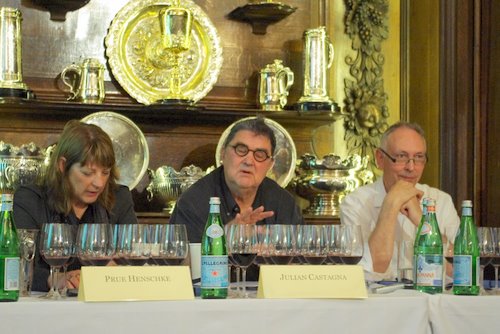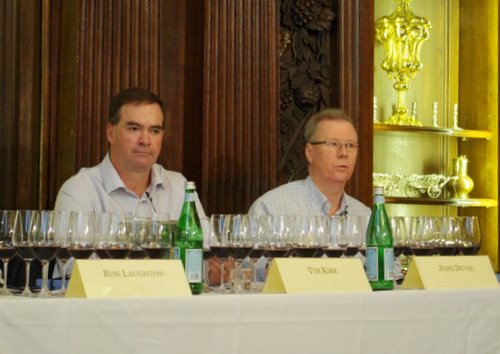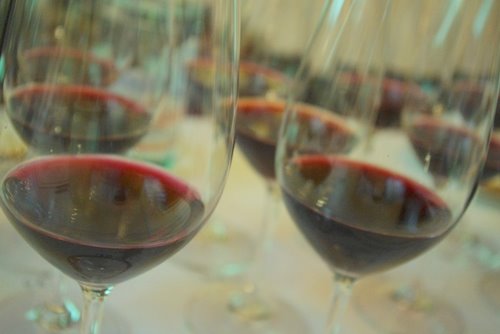Just on my way back from the Institute of Masters of Wine Australian Shiraz Masterclass. It was led by a distinguished group of Aussie winegrowers: Tim Kirk (Clonakilla), Julian Castagna, Prue Henschke, John Duval and Ron Laughton (Jasper Hill).

The line up of wines, was – on paper at least – quite stellar. Sally Easton MW had chosen them, and she did a great job. But on the day I found several to be quite disappointing. Sometimes wines just don’t show their best.
The Clarendon Hills Astralis 2004 and Torbreck Runrig 2006 were just too ripe, sweet, big and soupy. Bird in Hand Nest Egg Shiraz showed just simple fruit; Henschke Hill of Grace 1986 was on its last legs (very dry finish, quite evolved); Hill of Grace 2006 was all simple open fruit and five spice; Rockford Basket Press 2005 was simple and too alcoholic; Paringa Estate Reserve Syrah 2007 was a bit monolithic and oaky despite nice acidity and bright fruit; and Dahlwhinnie The Eagle 2005 was prematurely evolved, although it did show nice complexity.
But let’s be positive. There were also some wonderful wines. Tim Kirk’s Clonakilla Shiraz Viognier 2009 was thrillingly elegant, and the 2005 was also beautiful. Julian Castagna’s Genesis Syrah 2008 was elegant, complex and nicely meaty. Brokenwood Graveyard 2009 is just a baby, but it’s really pure and linear with lovely acidity. Jasper Hill Georgia’s Paddock is fresh, expressive and delicious and Penfolds RWT 2008 shows lovely purity of fruit and real definition.

The chat was good too. Prue had a mini rant about ‘green’ tannins. She thinks that this is a problem with much French Syrah. She says that when she tastes most lesser French Syrahs she thinks that the winemaker hasn’t been tasting in the vineyard. She also thinks green tannins never resolve with age and that these wines are only for people who have a personal preference for them – everyone else ‘should avoid them like the plague.’ I bet she wouldn’t like many of the northern Rhone Syrahs that I love. I disagree with this Aussie idea that tannins have to be tamed in the vineyard. That’s what elevage is for.
This led to a discussion about tasting grapes in the vineyard. There has been a big change, says John Duval, whose wines fit comfortably into the elegant new-Barossa style. 40 years ago winemakers didn’t go into the vineyard, he recalled. Now they walk the rows tasting the fruit. In his view, it is one of the factors that has contributed to rising alcohol levels. Winemakers say they are looking for ripe fruit flavours; for physiological maturity. Tim Kirk suggested that by time you get the flavours you want in the grapes, it’s probably too late. You have to then pick the vineyard, and in the delay between the tasting and the picking the flavours can be lost and the sugar levels can rise. Prue, however, was very keen on tasting and waiting for ripe tannins in the grapes, and Julian Castagna says that he doesn’t do any analysis of his grapes until the taste is right.
The issue of alcohol is indeed a thorny question, and it was raised by the audience. Old Australian classics used to have much lower alcohol levels; one of the wines in this tasting was 16% and another was 15%. Prue doesn’t think it’s necessarily a problem.
Tim Kirk raised an interesting point about the wrong steer that Australian Shiraz took a few years back. He thinks that American critic Robert Parker has a great palate, but that he has a preference for ripe wines, and the sorts of wines that he gave high scores to in Australia were very ripe, rich styles. The wines got stratospheric scores, and sold for high prices, so more people made wines in this stylistic direction. It was a big mistake.
So, a very interesting tasting and discussion that gave much food for thought. And 24 rather diverse wines. A treat for a Monday morning.
7 Comments on The IMW Australian Shiraz masterclass
I think that too many modern-day winemakers are overly obsessed with trying to avoid unripe tannins. They’ll sacrifice important aspects like balance (which is what great winemakers strive for), just so that they can avoid the slightest green/herbal nuance. It’s acceptable to have silky-tannined, high alcohol, high pH wine that tends to avoid projecting its place of origin if you’re aiming at the early-drinking lower end of the market, but surely one should try and create something special if one’s going to ask a premium for a wine (and late harvested grapes, ‘squeezed’ to oblivion in the cellar and drowned in new oak is not special – it’s not even new).
Can anyone – perhaps Prue – please explain the following to me (this is just me, trying to learn):
1. From what I’ve read and tasted, tannin softens during maturation, mostly through polymerization. As far as I have it, there’s no comparable lessening of alcohol content over time. In fact, many high alcohol wines tend to appear even more alcoholic over time as their other components mellow out, exposing the shortfalls of a lack of balance. Of course the same can happen to wines that have unbalanced or marked green tannins (mostly from bad canopy management or virused vineyards), but at least tannins CAN soften. Am I missing something that can lessen a wine’s alcohol (forget reverse osmosis, water addition, etc. – I’m talking about after bottling) even remotely as effectively as time works its magic on tannins?
2. Looking at basically all the best wines (worldwide) of yesteryear that have matured beautifully for decades, they all have lower alcohols (often 12% or 12.5%) than today’s often ridiculous 15%+. I remember tasting a Penfolds Grange Hermitage 1978 in the late nineties at around 13% to 13.5% alcohol and it was sublime. Global warming can only account for a small increase in sugar levels at full ripeness, but then viticultural and oenological advances more than make up for it. Since 15%+ alcohol table wines haven’t proven such brilliance over time yet, why do winemakers persist with them?
I can understand that winemakers might want to impress certain palates or try to overpower other wines in big competitions, but I haven’t been convinced by any argument for this over-ripe phenomenon that cites sheer quality or authenticity as goal.
Prue’s opinion is certainly interesting, but she should perhaps pay attention to the fact that many french producers, albeit a minority, do not destem their grapes. This results is a form of added freshness, and special “green tannins” taste and flavours that Prue may dislike, but that some amateurs (seems like Jamie is one of them) appreciate.
So, question: Is what Prue calls “green tannins” the effect of non-destemmed grapes ?
Olivier
Sounds awesome, though it’s good to hear the reality that some of these are overdone.
Btw, Are you interested in coming along to The Ledbury on 27th for David & Wendy Lloyd’s Eldridge lunch? You’re probably in some other country!
An interesting piece.
FWIW I do think that the Aussies themselves still seem to demand the style that’s being aimed for here, yet more and more I wonder whether home-market tastes will end up damaging brand Australia in the long run as the wines risk being seen as stereotypical / cliched (as if they aren’t already in many quarters!)
regards
Ian
Several MW candidates told me I should go to the Napa class instead of Austria, unless I had a personal love affair with Gruner. After reading this, I think I need to start saving for airfare to Australia! Sounds like an excellent tasting.
I remember going to a Grateful Palate tasting after Parker had gone through the portfolio. Over 200 wines with a few sips taken out; sloppy seconds. They showed so well in that setting, but so few ever made it to 10 years without fading away. The tannins were there, but no acid.
I used to drink a lot of Australian red wine. Now I don’t. Nor do lots of my friends. Too much alcohol. Anything over 13.5% goes back on the shelf.
I’m curious as to why Prue doesn’t think that this is “necessarily a problem”.
I agree with the comments regarding alcoholic strength. I see top-end Aussie wine (and California too) has now reaching almost perverse levels of alcohol strength. Given some of the makers’ ambitions, this can’t be solely down to the domestic market.
Take, for instance Jonathan Maltus’ Emigre – all 15.5% of it. I had a bottle recently and can only think that Maltus – who has Teyssier, Le Dome etc in Bordeaux as well – is chasing the Parker fashion for Big Alcohol which is a pity. There’s clearly a lot of thought gone into the wine, but I personally find it hard to get through the ‘stewed’ component of the flavour to get at what is good underneath it.